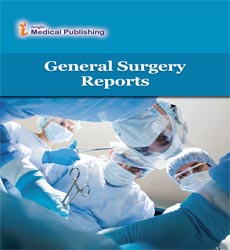Surgical Morbidity as Wound Infections in Patients
Jinni Jonas*
Department of Gynecology, Jilin University, Jilin, China
- *Corresponding Author:
- Jinni Jonas
Department of Gynecology, Jilin University, Jilin,
China,
E-mail: jinni jonas@gmail.com
Received date: August 14, 2023, Manuscript No. IPGSR-23-18468; Editor assigned date: August 16, 2023, PreQC No. IPGSR-23-18468 (PQ); Reviewed date: August 30, 2023, QC No. IPGSR-23-18468; Revised date: September 06, 2023, Manuscript No. IPGSR-23-18468 (R); Published date: September 13, 2023, DOI: 10.36648/ipgsr.7.02.137
Citation: Jonas J (2023) Surgical Morbidity as Wound Infections in Patients. Gen Surg Rep Vol.7 No.02:137.
Description
Nonalcoholic fatty liver disease is becoming more common as a result of an increase in the number of people with metabolic syndrome, which is altering the epidemiology of chronic liver disease. NAFLD is addressed by a wide range of conditions going from greasy liver to nonalcoholic steatohepatitis. As an outcome, the quantities of Liver Transplantation (LT) embraced in patients with cirrhosis because of NASH has been expanding around the world. Heftiness is known to be a free gamble factor related with the movement of liver illness in patients with cirrhosis from all causes. Patients with transplantation show a high rate of stoutness as the last option advances end-stage organ sickness, and transplantation causes an expansion in body weight optional to continuation immunosuppressive treatment with steroids that further develop hunger and general wellbeing after transplantation. The consideration of the transplantation clinical local area is centered on people with weight anticipating LT or those with transplantation are not just a result of the disturbing expansion in the commonness of stoutness yet in addition due to the specificities of LT in these people.
Surgical Morbidity
Obesity was found to be a risk factor for adverse outcomes among recipients of solid organ transplants, such as delayed graft function or graft rejection, graft loss, and death. As a matter of fact, the main source of join misfortune moved throughout recent a long time from unite dismissal to patient passing because of cardiovascular illness, showing that heftiness related co-morbidities, like sort 2 diabetes and hypertension, and their relationship with higher mortality might be significant indicators of result following transplantation. Many focuses have restricted the transplantation to patients with BMI <35 kg/m2 while others think about BMI somewhere in the range of 35 and 40 kg/m2 as an overall contraindication for transplantation. Obesity, according to recent research, increases surgical morbidity, such as wound infections, wound dehiscence, and hernias after transplantation, rather than affecting patient and graft survival. All the more altogether, abundance pretransplant body weight limits the pace of progress in wellbeing related viewpoints after LT. Bariatric Surgery (BS) has been suggested as a means of achieving this objective due to the high failure rate of diet control during the peri-transplant period. However, there is still a dearth of clinical experience in this area. It has been demonstrated that BS successfully aids in weight loss in obese individuals, resulting in numerous beneficial effects on associated metabolic disturbances. BS can be performed prior to, during, or following LT. The exact timing and kind of medical procedure in this particular patient populace stay dubious, with numerous contemplations to be considered.
Bariatric Medical
The present met-analysis centers around the grimness and mortality of BS in the setting of LT to characterize the planning of bariatric medical procedure concerning LT, previously, during, or later. BS after LT accompanies careful gamble of serious grips, wound complexities, and anastomotic dehiscence because of the utilization of steroids or potentially immunosuppressive medications. Sleeve gastrostomy is the most normally involved method in relocate patients. It has been liked over gastric banding to forestall the implantation of unfamiliar bodies and over gastric detour, to save the endoscopic admittance to the bile conduits and hypothetically, aversion of any malabsorption of immunosuppressive medications. Little quiet series have shown the utility of BS in patients with end-stage liver illness, previously, during and following LT. The point of our review is to evaluate, in a bigger partner of patients, the procedure, timing, and wellbeing of BS. The rate of horrible stoutness is expanding continually. Perhaps of the most well-known difficulty connected with weight is addressed by non-alcoholic greasy liver infection that can go from greasy liver to non-alcoholic steatohepatitis, which is continuously turning into the primary reason for endstage liver sickness and need for liver transplantation with liquor hepatitis. In addition, a number of factors increase the risk of morbid obesity in the post-transplant setting, and obese people undergoing liver transplantation rarely lose weight after the procedure. People with stoutness in the pre-and post-relocate setting benefit from weight reduction with decreased grimness and mortality. Bariatric medical procedure is compelling in actuating weight reduction and corpulence related clinical issues goal however its application in the liver transfer setting is restricted.
Open Access Journals
- Aquaculture & Veterinary Science
- Chemistry & Chemical Sciences
- Clinical Sciences
- Engineering
- General Science
- Genetics & Molecular Biology
- Health Care & Nursing
- Immunology & Microbiology
- Materials Science
- Mathematics & Physics
- Medical Sciences
- Neurology & Psychiatry
- Oncology & Cancer Science
- Pharmaceutical Sciences
